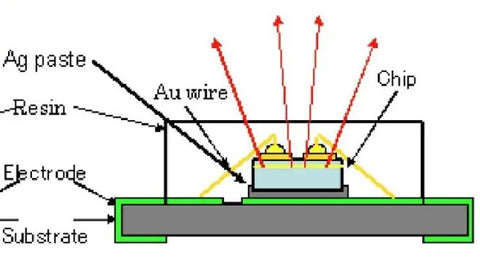They are LED (light emitting diode) bulbs. Some LEDs have tiny bulb shapes

but ours look more like chips. Because they are packaged with surface-mount technology and are called SMD (Surface Mounting Device) LEDs.

Many of the chips are arrayed to form lamps in our products
LANGY 120W Solar Street light 12000 Lumens Most Bright
Our stereotype light looks like the one the image below.

It is an incandescent light bulb. In human history, the lighting sources evolved from Sunlight, to fire, to candle, and to lights using gas or fuels. Then the incandescent light bulb using electricity as energy was invented. It was one of most important inventions in human history. The tungsten filament is placed inside a glass bulb filled with inert gas like nitrogen or in a vacuum. When it is charged with electricity, the filament is heated up and glows. However, 90% of the electricity is converted to waste heat but only 10% to visible light. Its efficiency is about 15 lumens/watt. Moreover, its lifetime is short, about a year or less.
Halogen lamp is another kind of incandescent light. Its filament is protected inside a glass and a small amount of halogen gas was added into the light bulb. This design increased its brightness and lifespan. It gives 25 lumens/watt.

Halogen lamp
Seeking for lower energy consumption and higher luminous output, people developed fluorescent lights with a new theory. The fluorescent tubes are filled with Argon and mercury. When excited with electrical current, they emit ultraviolet (UV) light which subsequently interact with the fluorescent coating on the tube to produce visible light. This new invention reduced electrical consumption and improved the luminous flux to 60 lumens/watt. The long tubular lights are often used in garages, kitchen, offices, such big open areas.


Fluorescent light compact fluorescent light
Engineers later designed the compact fluorescent lights and expanded their application fields. However, for the fluorescent lights, the switching of on and off greatly shorten their longevity and they don’t function well in cold temperature. In addition, it contains small amount of mercury and so needs special disposal measures.
A special class of lamps called High Intensity Discharge (HID) lamps were developed for applications in large open areas like stadiums, parking lots, and gymnasiums. The below pictures show a metal halide lamp, two high pressure sodium lamps, and a mercury vapor lamp.


Metal halide lamp Mercury Vapor Lamp

High Pressure Sodium Lamp
The inert gas and other metal chemical additives are filled in the bulbs. Under electrical charge, the gas is ionized and an “arc” is formed between the two tungsten electrodes. The electrical arc evaporates the metal salts inside the bulb and generates enormous amount of luminous flux. Examining their theories, the fluorescent light also belongs to HID lamps. Those lamps are more durable than fluorescent lights and generate much more lumens which make them suitable for outdoor and open area applications. However, they generate much heat and so not much energy efficient. Also, they need some “warm up” time, usually a few minutes, to reach their best performances.
LED is now adays the most energy-efficient, durable, compact and versatile lighting source with the longest lifetime. It is replacing the previous lights in various applications.LED is solid state lighting with a completely different theory. It has a few different structures for their suitable applications. Here I am using the SMD LED structure as an example to explain how it works. Refer to the image below.

A chip (semiconductor) on the Ag paste sits on the cathode. The Ag paste serves as a heat sink that allows good heat dissipation. Therefore, it enables the LED to operate at higher current and to produce more lumens. A gold wire called bond wire links the cathode to the anode. On the outside, a layer of transparent resin seals all the components, which leads the LED shock-resistant. The resin works as a lens in the same time. The substrate is often the printed circuit board. This design makes it easy to manufacture and assemble. When it is charged, the electrical current flows through the semiconductor and produces photons (light) and the light is directional.

A LED light fixture mainly consists of LED bulbs/chips, LED driver, optics, and power supply. In some applications where directional light is undesirable, the bulb is coated. So far, LED is the best light source. It lasts longer, saves more energy, produces less heat, resists shock, turns on instantly, and no harmful chemicals (mercury) like in the fluorescent light and some HID lights.
Upgraded LANGY 90W Led Solar Street Lights 9000 Lumens
Reference:
- https://www.watelectrical.com/different-types-of-lamps-in-lighting-system/
- https://www.stouchlighting.com/blog/the-historical-evolution-of-lighting
- https://justenergy.com/blog/types-light-bulbs-history-buying-guide/
- https://www.lightingtutor.com/pros-and-cons-of-led-lights/#:~:text=LED%20Bulbs%20Produce%20Less%20Heat%E2%80%93%20One%20of%20the,of%20what.
- https://en.wikipedia.org/wiki/LED_lamp
- https://lamphq.com/functional-principle-of-leds/#:~:text=How%20do%20LED%20lights%20work%3F%201%20Generate%20operating,purposes.%20...%204%20Optics%20for%20light%20distribution.%20



